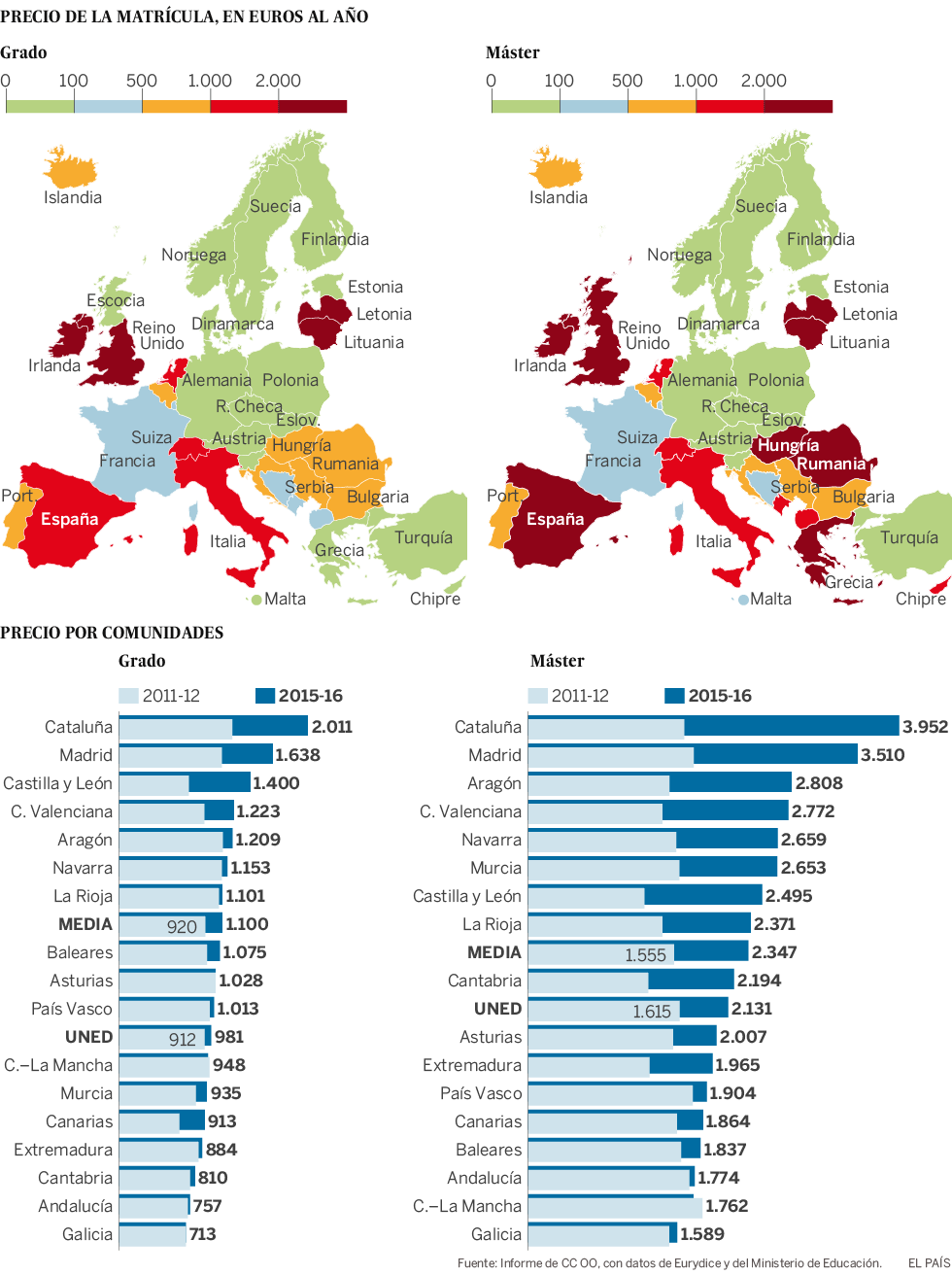 | ||
| Porcentaje de obesidad en mujeres por países en 2014, según un código de colores. Fuente: NCD-RisC, citado en el artículo. |
BLOG DEL PROFESOR ÁNGEL LUIS ALFARO ESTE CURSO NO IMPARTE ESTA MATERIA
martes, 26 de abril de 2016
Cuestión de peso
viernes, 15 de abril de 2016
lunes, 11 de abril de 2016
Geography Matters
 |
Life expectancy of 40-year-olds with household incomes below $28,000,
|
The Rich Live Longer Everywhere.For the Poor, Geography Matters.
By NEIL IRWIN and QUOCTRUNG BUINew York Times,
For poor Americans, the place they call home can be a matter of life or death.
The poor in some cities — big ones like New York and Los Angeles, and also quite a few smaller ones like Birmingham, Ala. — live nearly as long as their middle-class neighbors or have seen rising life expectancy in the 21st century. But in some other parts of the country, adults with the lowest incomes die on average as young as people in much poorer nations like Rwanda, and their life spans are getting shorter.
In those differences, documented in sweeping new research, lies an optimistic message: The right mix of steps to improve habits and public health could help people live longer, regardless of how much money they make.
One conclusion from this work, published on Monday in The Journal of the American Medical Association, is that the gap in life spans between rich and poor widened from 2001 to 2014. The top 1 percent in income among American men live 15 years longer than the poorest 1 percent; for women, the gap is 10 years. These rich Americans have gained three years of longevity just in this century. They live longer almost without regard to where they live. Poor Americans had very little gain as a whole, with big differences among different places.
Where the Poor Live the Longest
Where the Poor Live the Shortest
MEN
| New York City | 79.5 |
| San Jose, Calif. | 79.5 |
| Santa Barbara | 79.4 |
| Santa Rosa | 79.0 |
| Los Angeles | 79.0 |
| San Francisco | 78.8 |
| San Diego | 78.8 |
| Miami | 78.3 |
| Newark | 78.2 |
| Boston | 78.1 |
WOMEN
| Miami | 84.2 |
| New York City | 84.0 |
| Santa Barbara | 84.0 |
| San Jose, Calif. | 83.7 |
| San Diego | 83.4 |
| Port St. Lucie, Fla. | 83.3 |
| Newark | 83.2 |
| Los Angeles | 83.2 |
| Portland, Me. | 83.1 |
| Providence, R.I. | 83.1 |
MEN
| Gary, Ind. | 74.2 |
| Indianapolis | 74.6 |
| Detroit | 74.8 |
| Louisville, Ky. | 74.9 |
| Tulsa, Okla. | 74.9 |
| Toledo, Ohio | 74.9 |
| Oklahoma City | 75.0 |
| Dayton, Ohio | 75.1 |
| Knoxville, Tenn. | 75.1 |
| Las Vegas | 75.1 |
WOMEN
| Las Vegas | 80.0 |
| Oklahoma City | 80.2 |
| Tulsa, Okla. | 80.3 |
| Honolulu | 80.3 |
| Detroit | 80.5 |
| Cincinnati | 80.5 |
| Indianapolis | 80.6 |
| Des Moines | 80.6 |
| Gary, Ind. | 80.7 |
| Little Rock, Ark. | 80.7 |
Among the 100 largest metro areas in the U.S.
Suscribirse a:
Entradas (Atom)
Rebajas

Alfons López, en Público, 4 de julio de 2014
Mafalda (Quino)

Enlaces útiles (no respondo por su contenido ni actualización)
- Comunidades autónomas de España - Juego de localizar en mapa mudo
- Provincias de España - Juego de localizar en mapa mudo
- 25 ciudades del mundo - Juego de localizar en mapa mudo
- Grandes países - juego de localizar en mapa mudo
- Glosario de términos geográficos para las pruebas de acceso a la universidad (IGN)
- Mapas Palas Atenea
- Un paseo por las Placas de Nivelación en Madrid
- Adivinar localización con Street View de Google
- Mapa Europa Air Quality Index
- El precio del ‘dumping social’
- The fish farm of the future - interactive
- Historia de una cuchara de plástico (Greenpeace)
- Concurso Constitución
- Concurso Dieta mediterránea
- Juego de mapas interactivos
- El mapa que explica de dónde son originarios los alimentos
- 10.000 millones de personas poblarán la Tierra en 2053 África doblará su población, mientras algunos países europeos perderán hasta el 20% de sus habitantes
- Media España está a menos de un kilómetro de una carretera Un nuevo método evalúa el impacto de las infraestructuras humanas sobre la fauna
- El Big Data inmobiliario - Historia y trayectoria del mercado residencial del Paseo de la Castellana (y III)
- Radiografía de las armas en España: hay una por cada 16 habitantes - ABC, 2016
- Voting in 2012, NYT
- ¿«Price-driven» o «buscacaprichos?: descubre cómo eres cuando haces la compra Se distinguen cinco tipos de consumidores a la hora de planificar lo que se necesita en el hogar y tirar a la basura cuando el producto caduca o se estropea
- Mapa y Listado de municipios de la Comunidad de Madrid
- Digiatlas. Cartografía digital: mapas y planos. Mapas vectoriales de España y el resto del mundo.
- Oriente Medio político con nombres en inglés. Vertical
- Cuenca del Mediterráneo ríos mudo (válido para Historia).
- España político con nombres (provincias, comunidades y capitales) en color (difícil de imprimir)
- España político con nombres (provincias) imprimible
- Europa político con nombres (Estados y capitales) en inglés. Vertical
- Europa político con nombres (Estados y capitales) imprimible
- Asia político con nombres (Estados y capitales) imprimible
- África político con nombres (Estados) imprimible
- América político con nombres (Estados) imprimible
- África político con nombres (Estados y capitales) imprimible
- Planisferio político con nombres imprimible pdf
- Planisferio político con nombres imprimible jpg
- Currículum en línea (mapas)
- ¿Es tu casa grande o pequeña? Así es el tamaño de las viviendas de España
- Mapas mundi "eurocéntricos" y alternativos
- El mapa de las bandas juveniles violentas en España
- Porcentual - Portal de noticias estadísticas
- Comparación ingresos familiares
- Capitales de Europa y otros juegos
- Curioso artículo de Ruiz de Elvira sobre el clima
- ODS- Objetivos de desarrollo sostenible
- PGOU Torrejón de Ardoz
- Plano de transportes de Torrejón de Ardoz
- La lucha por la tierra se libra en las ciudades latinoamericanas En el suelo que hasta ahora solo interesaba a los pobres hay hoy especulación que expulsa de sus casas a quienes allí viven GRÁFICO ¿Hay relación entre crimen y barrios pobres? El caso de Buenos Aires
- United Nations Cartographic Section
- Comunidad de Madrid político mudo
- Comunidad de Madrid físico mudo
- España físico simplificado mudo
- España provincial y comunidades mudo
- Europa físico mudo
- Europa político mudo
- Planisferio físico mudo 20º
- Planisferio mudo ríos sin coordenadas
- Planisferio Mercator político mudo 15º
- Otros mapas
- Apuntes por temas, glosario, etc. IES Dionisio Aguado
- Videos del INE
- Así tuitea España
- Ebola for beginners: Twitter map outlines some elementary geography
- Internet no duerme (vídeo)
- Internet no duerme
- Currículo de Bachillerato (todas las asignaturas)
- Coordinación PAU (todas las asignaturas)
- Ejercicios prácticos - Blog de Alberto Molina
- Atlas Geográfico - José Javier Martínez
- 20 mapas que cambiarán tu forma de ver el mundo
- Mapa del suicidio en España
- MAD//13 - Madrid Aerial Demo-Reel
- Artículo sobre el informe (ABC, 3/02/2014)
- Análisis del consumo energético del sector residencial en España
- Simulan el clima de la Tierra Media de Tolkien
- Ley de Zipf o rango-tamaño
- Dibujantes de mapas simbólicos, en laboratorio
- Mapas, mapas, mapas, Enric Juliana
- Flightradar24. Mapamundi con vuelos comerciales en tiempo real
- Blog de un profesor
- Un informe de la OCDE concluye que la economía crecerá [a] un 3% hasta 2060
- Aprender geografía con el «método zombi»
- 2º Bachillerato (Instituto Geográfico Nacional)
- Mapas (Estrabón)
- Recursos (El Sueño del Cartógrafo)
- Comentario de fuentes de información (Wikipedia)
- Relieve de España (Wikipedia)
- Costas de España (Wikipedia)
- Clima de España (Wikipedia)
- Hidrografía de España (Wikipedia)
- Bosques de la Península Ibérica (Wikipedia)
- Paisajes rurales españoles (Wikipedia)
- Las formaciones vegetales (trabajo de alumno)
- Los paisajes vegetales (McGraw) -incluye suelos-
- Comentario pirámide (presentación genérica)
- Prácticas
- Vocabulario
- Vocabulario (IES Alquibla)
- IES Albarregas (Mérida)
- IES Galileo Galilei (Sevilla)
- IES Juan Carlos I Ciempozuelos
- IES Núñez de Arce (Valladolid)
- IES Ramón Carande (Jerez de los Caballeros)
- Variables geográficas (IES Ramón Carande)
- Relieve (IES Ramón Carande)
- Clima (IES Ramón Carande)
- Ríos (IES Ramón Carande)
- Vegetación (IES Ramón Carande)
- Agraria (IES Ramón Carande)
- Industria (IES Ramón Carande)
- Servicios (IES Ramón Carande)
- Población (IES Ramón Carande)
- Agencia Estatal de Meteorología
- Colegio de Geógrafos
